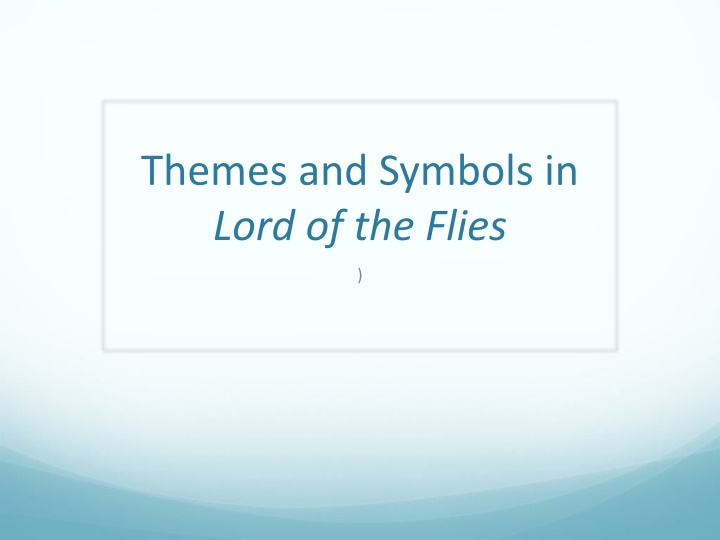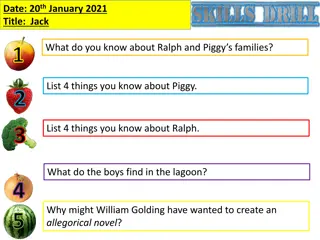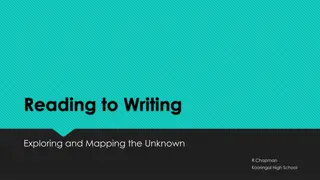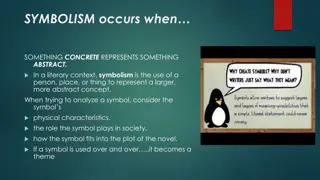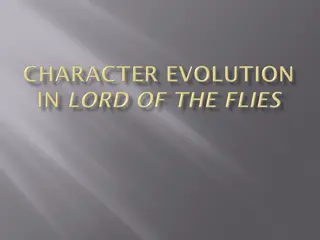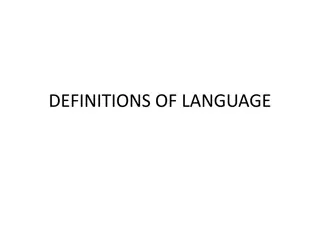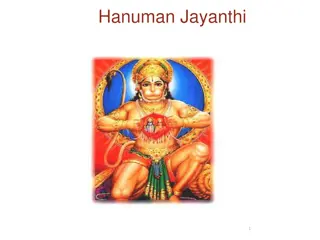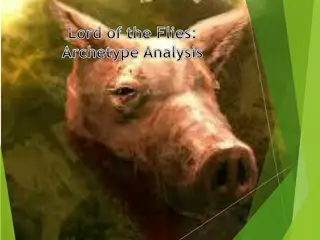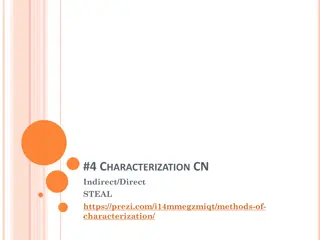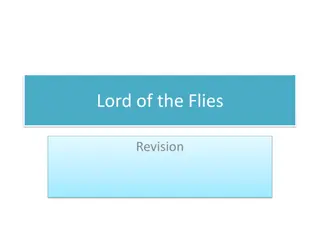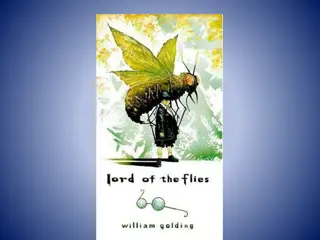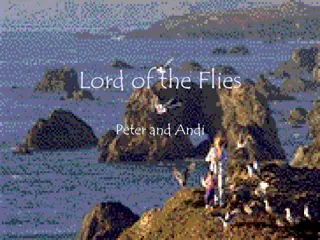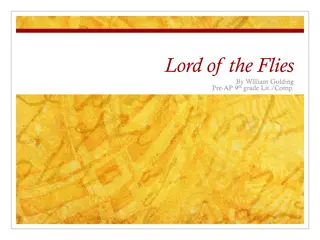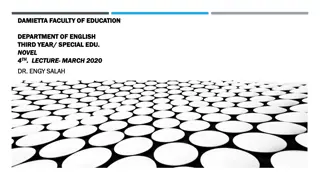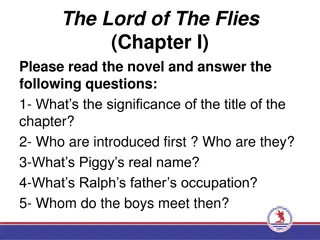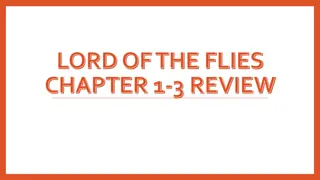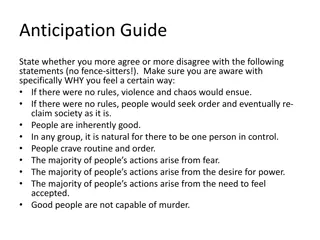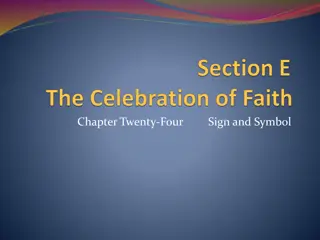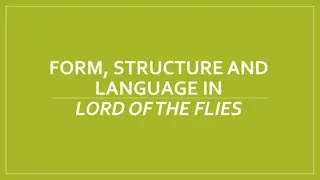Themes and Symbols in Lord of the Flies
Explore the themes of the fall of man, man's savage nature, violence, friendship, obedience, peer pressure, democracy vs. dictatorship, and symbols like the conch, Piggy's glasses, face paint, the beast, and fire in the classic novel "Lord of the Flies" by William Golding. The story delves into the descent into savagery and the struggles between order and chaos, civilization and primal instincts through the characters and symbols present on the isolated island.
Download Presentation

Please find below an Image/Link to download the presentation.
The content on the website is provided AS IS for your information and personal use only. It may not be sold, licensed, or shared on other websites without obtaining consent from the author.If you encounter any issues during the download, it is possible that the publisher has removed the file from their server.
You are allowed to download the files provided on this website for personal or commercial use, subject to the condition that they are used lawfully. All files are the property of their respective owners.
The content on the website is provided AS IS for your information and personal use only. It may not be sold, licensed, or shared on other websites without obtaining consent from the author.
E N D
Presentation Transcript
Themes and Symbols in Lord of the Flies )
Themes/Topics The fall of man Man s savage nature Violence
Themes/Topics cont. Friendship Obedience/peer pressure Democracy vs. Dictatorship
Symbols conch A symbol is something that represents something else, either by association or by resemblance. broken-glasses The conch The fire Piggy s glasses The Beast War Paint The island cat-eyes lord_of_the_flies jack fire
Symbols The Conch- It represents order and civilization. It also symbolizes democracy as it enables anyone to have a voice at the meetings. The conch soon becomes a meaningless symbol as there is no system of society to give it meaning. As the boys move further into savagery, the conch is increasingly ignored until it is eventually destroyed, symbolizing the end of civilization. Piggy s glasses- They represent clarity and foresight. They are a symbol of civilization as well as a method of supporting the vulnerable like Piggy. They are also the key link to the civilized world in that they produce the fire which is the boys only hope of rescue. Face paint- The face paint represents the descent into savagery. The boys become separated from their civilized selves through the anonymity of the paint, and this allows them to engage in savage actions. It is also linked to superstition and a more primal way of life.
Symbols cont. The Beast- It represents their own fears and the growing violence and evil which is taking hold of them. The beast starts off as a beastie, something dreamed up by the littluns, but it soon takes hold of all the boys to the point where eventually Jack and his crew leave it a sacrifice as if it were some sort of God. The beast is also described as a snake like thing, linking it to Satan in the Garden of Eden in Genesis, the cause of Man s fall. However, instead of the devil, in Golding s story, it is Man s own savage nature that results in the fall of the boys and the transformation of the island from a paradise at the start to a flaming inferno (hell) at the end. Fire- In one sense fire represents civilization. It provides warmth and allows the meat to be cooked. It is also the boys only hope of getting home. On the other hand, fire can be seen as destructive and savage. The boys set fire to a large part of the island at the start, and the end of the book Jack s tribe start a huge fire. Fire, like the boys, can be both good and evil.
Characters Ralph- Ralph is the one who blows the conch and is therefore associated with this symbol of order and authority. Ralph wants things to go well on the island and realizes the most important thing is to be rescued. Throughout the book, we see Ralph s loss of innocence and growing awareness of the dark nature of man. Ralph symbolizes a desire for civilisation and democracy; he believes in good but is not able to stop things from falling apart, nor is he completely immune to the powerful temptation of savagery. Jack- Jack more than any other character shows the descent from civilization to savagery. In contrast to the first meeting where he claims that rules are vital, he rejects them and starts his own tribe. Jack s tribe are only concerned with pleasure seeking and the violent rewards of hunting, and Jack sets himself up as a sort of God or idol. Jack can be seen as a symbol of man s inherent savagery and the dangerous possibilities of dictatorship.
Character cont. Piggy- Piggy is the ultimate outsider. He is overweight, wears glasses and suffers from asthma. He is also from a lower-class background. Piggy is routinely teased by the rest of the group which reflects their primal instinct to target the weak and vulnerable in society. Piggy is actually the clearest sighted of them all. He maintains the need for rules and values the conch above all others. Piggy represents logic and clear-sightedness; however, he also represents the weaker elements of society that are protected by the rules of civilization. Simon- Simon represents goodness and is presented as a sort of savior, saint-like figure. He is the only one of the elder boys to care about the welfare of the littluns. Simon is the only boy who is in harmony with the island. He is also the only one who truly understands what the Beast is. The other boys mock Simon and think him strange and even mad, showing that his essential goodness and clarity of vision are not valued.
Characters cont. The Littleuns- The Littleuns represent the masses. The population in general. They are easily scared and easily entertained and their main concerns are with basic needs (food, shelter, warmth etc.). The Littleuns are protected by altruism (Simon) and civilization (Piggy and Ralph). Dictators like Jack rule through fear and don t care about the needs of the masses.
